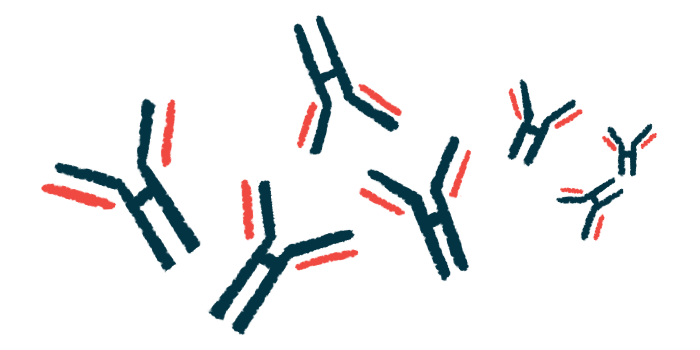Autoantibodies at SLE diagnosis tied to higher risk of disease flares
Patients identified at higher risk of flares may benefit from close monitoring

People who are positive for two types of autoantibodies at the time of their systemic lupus erythematosus (SLE) diagnosis have a higher risk of disease flares, a new study reports.
Compared with people who were negative, those positive for autoantibodies against double-stranded DNA (dsDNA) and the Smith protein (Sm) had a 3.34-times higher risk of experiencing disease flares.
“Patients who are double-positive for anti-dsDNA and anti-Sm Abs [autoantibodies] at the time of the diagnosis of SLE are at higher risk of flares and may benefit from stringent monitoring and early preventive treatment,” researchers wrote.
The study, “Risk of systemic lupus erythematosus flares according to autoantibody positivity at the time of diagnosis,” was published in the journal Nature Scientific Reports.
Antinuclear autoantibodies play key role in SLE attacks
SLE is the most common and serious form of lupus, a chronic autoimmune disease that can affect many organs and has a wide range of symptoms. Playing a key role in these attacks are a certain group of antibodies called antinuclear autoantibodies (ANAs), which target molecules found in the nucleus of cells, where genetic information is stored.
Lupus is characterized by episodes of sudden symptom worsening and high disease activity, known as disease flares, which are then followed by periods of mild or no symptoms. These flares can vary in severity and duration, with the more severe ones requiring medical care. Additionally, studies have shown that more flares can increase the risk of SLE damage accumulation.
“Therefore, it is important to identify patients with SLE at an increased risk of flare, preferably at early stages of the disease, as it can lead to optimized monitoring and preventive treatment,” the researchers wrote.
The importance of ANAs in SLE and its progression is well-established, and the presence of certain ANAs have been linked to specific characteristics of SLE. However, little is known about how the presence of specific ANAs at the time of diagnosis can affect the risk of flares over the course of the disease.
To address this, a team of researchers in South Korea conducted a retrospective study using data from people who were diagnosed with SLE between January 2009 and December 2019 at a hospital in Seoul, and were tested for the presence of several ANAs at the time of diagnosis. These included ANAs targeting dsDNA, Sm, U1 ribonucleoprotein (U1RNP), Ro protein, and La protein.
The study included 228 individuals, who were followed up for at least one year after diagnosis up to December 2021, or until they had an SLE flare. Patients had a mean age of 38.3 years and the majority (92.1%) were female. Most of them were treated with hydroxychloroquine (93.4%) and all received glucocorticoids.
Patients who are double-positive for anti-dsDNA and anti-Sm Abs [autoantibodies] at the time of the diagnosis of SLE are at higher risk of flares and may benefit from stringent monitoring and early preventive treatment.
78% of SLE patients experienced a flare during follow-up
At diagnosis, anti-Ro autoantibodies were detected in 54.8% of the patients, while anti-dsDNA autoantibodies were detected in 50%, anti-U1RNP in 42.5%, anti-Sm in 30.7%, and anti-La in 22.4%.
During follow-up, which lasted a median of 1.9 years, 78.5% of SLE patients experienced a flare, with 40.4% having severe flares and 38.2% mild-to-moderate flares.
Analyses showed that SLE patients who were positive for anti-dsDNA and anti-Sm autoantibodies had a significantly increased risk of experiencing flares: a 46% increase with anti-dsDNA and an 81% increase with anti-Sm.
Repeating the analyses for severe flares and mild-to-moderate flares separately showed that the presence of anti-dsDNA antibodies at diagnosis was associated with a 63% increase in the risk of experiencing a severe flare, whereas anti-Sm antibodies were linked to an 88% increased risk of mild-to-moderate flares.
To better define the risks associated with these two ANAs, SLE patients were divided into groups based on the presence of anti-dsDNA and anti-Sm antibodies: those who had neither (double negative), those who had one of them (single positive), and those who had both (double positive).
Some demographic and clinical characteristics differed significantly between these groups. For example, double-positive patients were younger than double-negative ones, patients positive for anti-Sm antibodies more commonly had musculoskeletal SLE symptoms, and those positive for anti-dsDNA antibodies were more likely to have kidney involvement.
Double-positive patients had highest risk of experiencing flares
When assessing the risk of flares in these patient groups, the researchers found that double-positive patients had the highest risk of experiencing flares, which was 3.34-times higher than that of the double-negative group. Double-positive patients also had a 2.93-times higher risk of severe flares and a 2.8-times higher risk of mild-to-moderate flares.
By contrast, patients who were single-positive for either anti-dsDNA or anti-Sm antibodies were not at a significantly higher risk of experiencing flares compared with those who were double negative.
“These results suggest that patients at higher risk of flares who may benefit from close monitoring are those who are double-positive for anti-dsDNA Ab and anti-Sm Ab, rather than those who are single-positive for each autoantibody,” the researchers wrote.
Larger, prospective studies would be useful to further explore this association between anti-dsDNA and anti-Sm antibodies and the risk of flares, the researchers wrote, particularly studies involving patients of different ethnicities and that assess fluctuations in antibody levels during follow-up.








